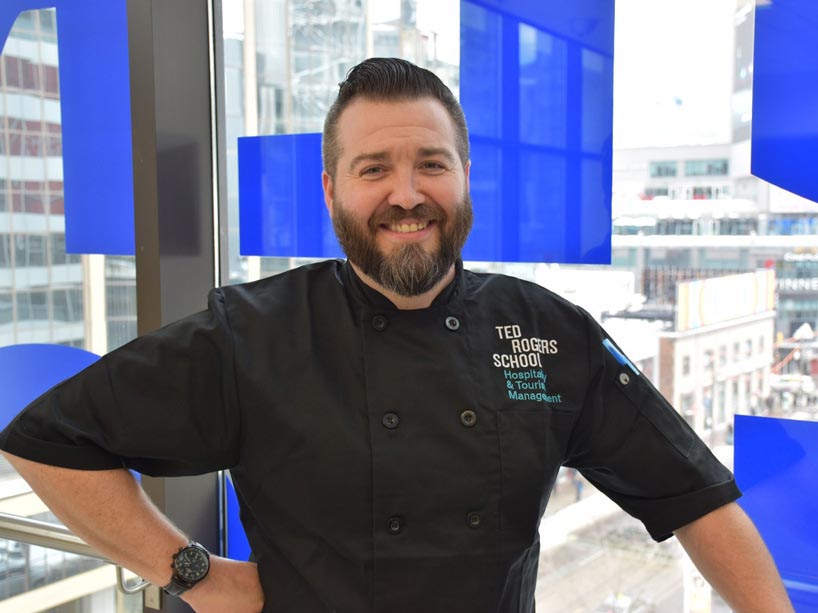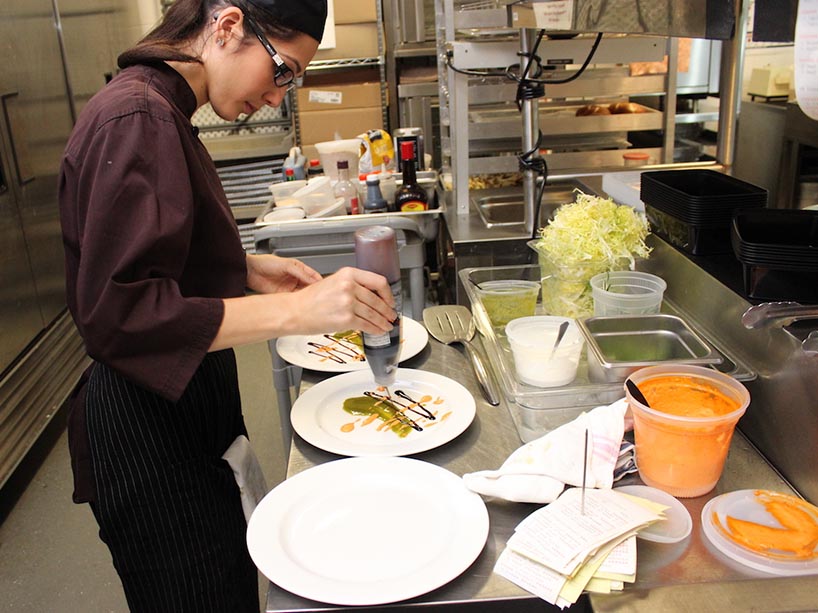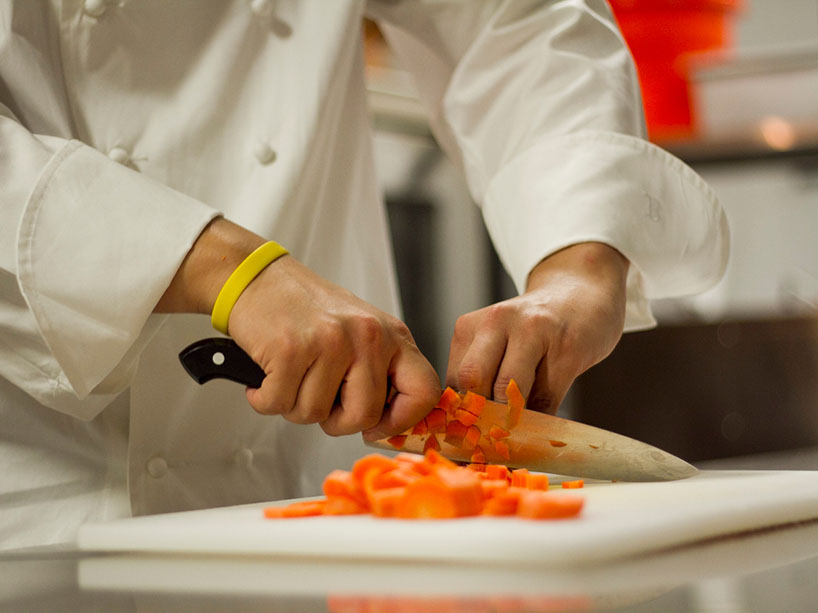Tired of fast food? Read on for expert culinary tips, seasonal recipe and campus fine dining options.

Food accessibility is the focus at campus eateries Ted's Kitchen and The Met Dining Room, both run by Executive Chef Tommy McHugh at the Ted Rogers School of Hospitality and Tourism Management.
Food accessibility is on the menu at the Ted Rogers School of Hospitality and Tourism Management.
Good food shouldn’t be exclusive, says Hospitality and Tourism Management Executive Chef Tommy McHugh. Read on to find out what motivates his approach to the culinary arts, discover fine-dining options on campus, access a delicious seasonal recipe and find tips to build your confidence in the kitchen.
Dishing out food knowledge and access
During his time working at five-star rated hotels and a Michelin-rated restaurant in the U.K., McHugh noticed that high-quality produce, meat and dairy were easily found in popular grocery store chains, but not necessarily so back home in Toronto.
Ontario produces excellent quality food, says McHugh, but food accessibility remains an issue, in particular for students who face more financial constraints. “Here, top quality food items are usually only found in specialty or fine food stores, which means most people only have processed or subpar options.”

Chef Tommy McHugh is helping to train the next generation of hospitality and culinary industry professionals with an eye towards the future of the sector.
Farm to table
The lack of access to quality food prompted McHugh’s conscientious approach to hospitality with the adoption of inclusive practices. That’s why campus eateries Ted's Kitchen and The Met Dining Room, both run by Chef McHugh out of the Ted Rogers School, use only locally sourced top-quality ingredients for their dishes, at a fraction of the cost you would find anywhere else in the city. The restaurants are both Feast On certified (external link) , which is a government issued certification for hospitality establishments that use over 65 per cent locally produced food items.
“We have a lot of people that are amazed that they can get a fresh prosciutto panini, with truffle dipping sauce for about $10. Our diners tell us they can't even get a burger for $10 at most of the fast food restaurants,” he says.
For McHugh, cultivating an appreciation for good quality food and ensuring it’s within reach for students is his ultimate goal.
Industry hands-on learning

Students receive hands-on training as part of the hospitality and tourism program.
Students in the hospitality and tourism program benefit from working at the campus food establishments, acquiring experiential learning in areas of menu planning and food production and preparation, food safety, front-of-house and back-of–house coordination, and more.
“The kiosk is completely student run. Not only are students learning about the industry hands-on, but they are also having conversations about food, food knowledge and supporting local producers,” says McHugh.
A fall favourite for foodies

Chef Tommy McHugh shares an original seasonal recipe for a great fall meal at a low cost. Photo by Sandie Clarke on Unsplash
Chef McHugh shares an original seasonal recipe for a great fall meal at a low cost, and as a side, tips to build your confidence in the kitchen.
Enjoy some fall flavour with the creamy and comforting (and budget-friendly) butternut squash soup recipe below, using seasonal produce from your local farmers market.
From Chef Tommy McHugh
Makes 2 liters / 4 portions
- ($4.00) Butternut squash x 1 piece
- ($0.50) Canola/veg/olive oil x 100 ml
- ($1.50) Onion x 1 piece
- ($0.25) Garlic x 2 cloves
- ($0.25) Veg stock bouillon cube x 1 piece
- ($0.00) Water x 2 liters
- ($0.50) Sour cream x 1 spoonful
- ($0.30) Pumpkin seeds x 1 spoonful
- ($.10) Kosher salt x 1 teaspoon (add more if preferred)
- ($0.05)Fresh pepper x to taste
- TOTAL = $7.45 / 4 = $1.86 per portion
- TOTAL (without sour cream & pumpkin seeds) = $6.65 / 4 = $1.66 per portion
Equipment:
- Kitchen knife
- Cutting board
- Kitchen cloth x 2
- Pot with lid
- Wooden/plastic spoon
- Veg peeler
- Measuring cup
- Hand blender
- Sieve (if wanted)
- Tasting spoon
Method:
Take some kitchen paper towel, dampen and place onto your counter. Place a cutting board on top, which will stop it from sliding and being dangerous when chopping.
Next, peel your onion and slice as thinly as you feel comfortable doing. Do the same for the garlic, but be sure to remove the “germ” (green core), as it causes stomach gas and discomfort.
Place the oil and these items into the pot on the stove which should be at half heat, increase the heat if you need to start hearing and seeing a light searing happening. Place the lid on top, being sure to stir every couple of minutes.
CAREFULLY cut the squash in half, scoop out the middle and peel the skin off. Cut into large chunks, and add to the onion and garlic in the pot. Mix, add the water and the bouillon cube, salt and pepper.
Place the lid back on top, and bring to a simmer (not a hard boil).Every five minutes remove the lid allowing the liquid gathering on the pot lid to fall back into the soup (that’s concentrated flavor!) and give a stir and a taste, then place the lid back on top.
Continue this until the squash is SOFT. It’s crucial the squash is super soft, or else your soup will taste uncooked and woody. Once your squash is super soft, take the lid off, turn off the heat and CAREFULLY use a hand blender to puree the soup. If you really want a velvety consistency, you can use a power blender. (Please note: only fill the blender cup 1/3 full and turn on slowly as the soup will expand instantly in the blender, and might blow the lid off and splash you with hot soup.
Cover the lid with a cooking cloth when blending to be extra sage. Pass the soup into a storage container, and taste the seasoning one last time. Don’t be afraid to use more kosher salt and pepper to get the soup where you want it!
Pour the soup into a bowl, add a spoonful of sour cream and sprinkle with pumpkin seeds.
Delicious soup, that’s straightforward, is cheap as chips and freezes super well!
Enjoy!
TMC
Skill up in the kitchen

Investing in a good knife is one of a few tips to help build your confidence in the kitchen.
Chef McHugh offers expert culinary tips to keep in mind when cooking:
- Clear the clutter and make a clean workspace for yourself when cooking a meal.
- A sliding cutting board poses a hazard, use a damp paper towel underneath to add grip.
- Don't throw out those vegetable peels. Store them in a large resealable plastic bag, pushing out any air, label and date the bag, and store in the freezer. Keep adding to the bag until it’s full, then boil the contents for two hours with herbs for the best vegetable stock.
- Invest in a good kitchen knife, you’ll have it for life.
- Batch cook when you can and make multiple servings you can freeze for future meals.
For the love of good food
October 20 marks International Chefs Day, a time to celebrate cooking and educate others about the industry. Chef McHugh’s passion for making quality, healthy and accessible meals deserves the spotlight this month. His progressive approach to food service will guide the next generation of culinary and hospitality professionals. Our highest compliments to the chef!
Book a table at the Met Dining Room by making a reservation through OpenTable here (external link) .
Related stories:
- From transit to health care to urban planning, why your vote matters
- Transit tips from a TMU expert
- Nutrition tips for students: Why our relationship with food matters
- Tips for time outdoors: How exposure to nature positively affects mental health
- Healthy sexuality for students: Healthy sex, healthy body, healthy mind
- Cybersecurity tips for students: Stay safe on social, avoid scams, protect your accounts and more
- Anxiety tips for students: advice for managing social anxiety and shyness